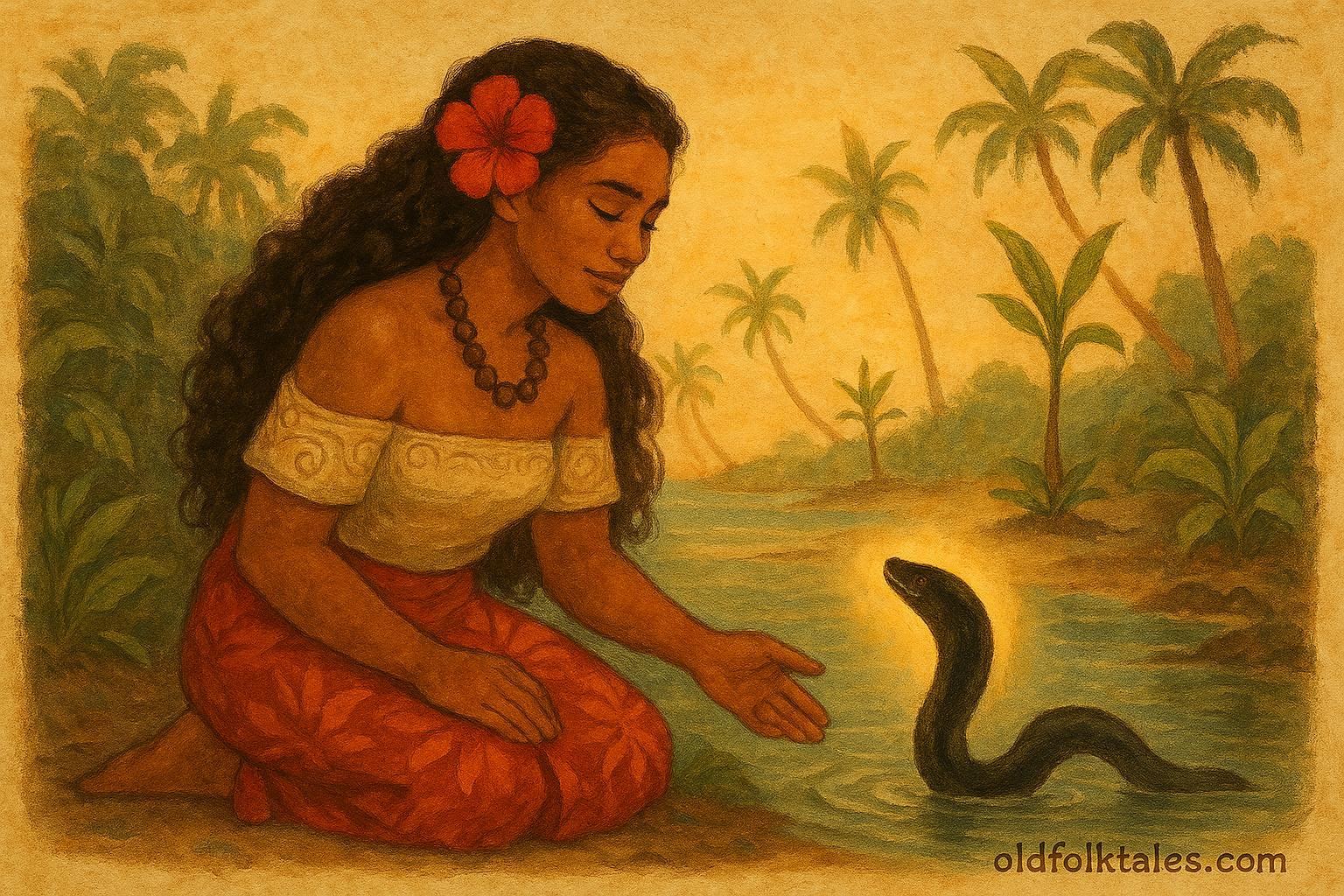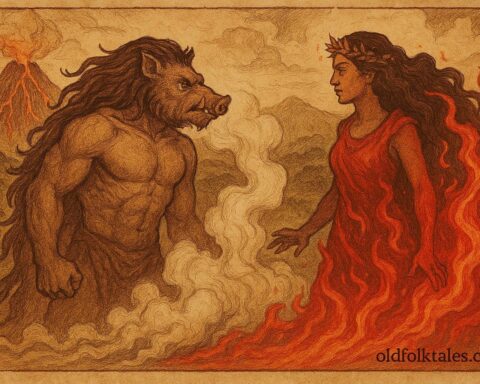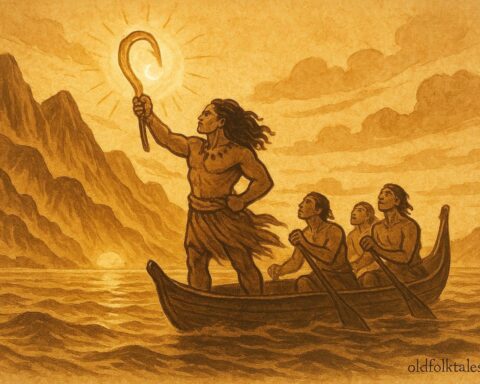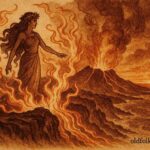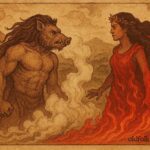Long ago, in the ancient islands of Samoa, there lived a maiden named Sina, whose beauty was said to rival the morning light over the lagoon. Her eyes sparkled like the sea, her hair flowed like black coral vines, and her laughter carried across the village like music. All who saw her agreed that Sina was touched by the favor of the gods.
Sina lived near a clear freshwater pool surrounded by palms and wild ginger blossoms. Each morning, she came to draw water, and each evening she bathed as the sun sank into gold and crimson waves. It was here, beside this pool, that her life took a turn unlike any other mortal’s.
One day, as Sina knelt to fill her gourd, she noticed an eel gliding silently beneath the surface, its sleek body glimmering like polished obsidian. Startled at first, Sina stepped back, but the eel spoke gently in a voice that rippled through the water like song.
“Do not fear me, Sina. I mean you no harm. I have watched you from the depths of the sea and followed the scent of your kindness. I am no ordinary eel but a spirit of the ocean who has taken this form to dwell near you.”
Sina, though cautious, felt no threat in his tone. Day by day, the eel appeared again, speaking softly and bringing her comfort with tales of the deep, of coral palaces, singing shells, and the glow of the moon on the waves. She began to look forward to his visits, finding in his words a strange wisdom and gentle affection.
As the moons passed, their friendship deepened. Yet, the villagers began to whisper. They warned Sina that she consorted too often with the mysterious eel. “Be careful,” said the elders. “Spirits take many forms, and love between the mortal and the divine can bring both blessing and sorrow.”
Still, Sina’s heart was tender. She could not turn away from her friend, even as she noticed his visits growing less lively and his voice more weary.
One afternoon, the eel lay still near the edge of the pool, his eyes dimmed. He called softly, “Sina, my time has come. The ocean calls me home.”
Tears welled in Sina’s eyes. “Do not leave me,” she whispered.
He smiled faintly, his scales glinting like fading sunlight.
“I was once a god of the sea, but my love for you bound me to this form. When I die, bury my head in the earth beside your house. From it will grow a tree unlike any other. Its fruit will sustain your people, and whenever you drink from it, you will see my eyes, watching over you always.”
As the stars rose, the eel breathed his last. Sina wept and carried his head tenderly to the spot he had chosen. She buried it in the soft soil, just as he asked.
Days later, a small green shoot broke through the ground, slender, graceful, and full of promise. Sina watered it daily, whispering to it as she once had to the eel. The plant grew quickly, its leaves unfurling toward the sky, until it became the first coconut tree.
In time, the tree bore fruit, round, smooth, and filled with sweet water. When Sina opened one, she gasped in wonder: each coconut bore three small marks near its top, like the eyes and mouth of the eel. When she drank from it, she felt the cool liquid touch her lips and thought she could hear his voice, soft as the waves:
“I am with you always, Sina. My love watches over you.”
From that day forward, the Samoan people called the coconut niu, and they remembered that it came from the love between Sina and the eel. They taught their children that when one looks at a coconut’s face and drinks from its shell, they share in the blessing of that first divine love, a love that gave humanity one of nature’s greatest gifts.
Generations passed, but the story of Sina and the eel remained. Mothers told it to their children beneath moonlit palms, and travelers repeated it across the islands. It was a tale not just of love and loss, but of transformation, of how something once feared could become something nourishing and eternal.
Even now, the people say that when you drink from a coconut, the cool water carries the memory of Sina’s tears and the eel’s devotion. And when you look into the “eyes” on the shell, you look into the gaze of the god who gave himself for love, a love that lives on in every island tree and every heart that believes in the sacred bond between the earth and the divine.
Moral Lesson
The legend of Sina and the Eel teaches that love can transcend form and endure beyond death. From sorrow and transformation can come new life and nourishment for generations. It reminds us to cherish what is given with love, for even loss can blossom into everlasting beauty.
Knowledge Check (Q&A)
- Who was Sina?
Sina was a beautiful Samoan maiden beloved by the gods for her kindness and grace. - Who was the eel?
The eel was a transformed ocean god who fell in love with Sina and chose to live near her in the form of an eel. - What did the eel ask Sina to do before he died?
He asked her to bury his head in the earth, promising that a new plant would grow from it to bless her people. - What grew from the eel’s buried head?
The first coconut tree, whose fruit bears marks resembling the eel’s face. - What is the symbolic meaning of the coconut’s “eyes”?
They represent the eel’s eternal watchfulness and love for Sina, connecting the natural world to divine memory. - What is the main lesson of this folktale?
That love and sacrifice can create lasting blessings,even from death comes new life.
Source: Adapted from Samoan Myths and Legends by J.W. Stair (1897)
Cultural Origin: Samoa (Polynesia)
